GATORADE Low calorie Fruit Punch
Gatorade or water?
In whatever beverage we drink at least half is water. Even we ourselves consist of 60% water. No wonder that pure water is a vital nutrient by itself. What do we really want when we are thirsty; soda, beer, juice or milk? What our body actually needs is water only. If this sounds boring to you, here is Gatorade; a creature of the beverage industry an attempt to “enhance” water. On the Gatorade Fruit Punch label you can read a long list of functions the beverage can give to you:
GATORADE G2
Low Calorie Thirst Quencher
Fruit Punch
(naturally and artificially flavored)
32 LF OZ 91QT) 946 ml
Electrolytes + carbs (5 g)
Replenish vital nutrients and energy
Drink to help rehydrate, replenish and refuel. And savor the sweat.
For ATHLETES. For PERFORMANCE
Sounds so impressive, doesn’t it? But is there something misleading or false on the label? Not really, except “fruit punch.” Beware there is absolutely no fruit resides inside the bottle. Let us see what is so special about this beverage that makes it such a popular nutritional elixir?
Well, not much, as far as I can see: water, sugar, salt, artificial flavor, a couple of benign inorganic chemicals outweighed, in my opinion, by the three foreign non-nutritional additives. With every gulp of Gatorade Fruit Punch you get a load of sodium, a tiny bit of potassium and some sugar. Along with that you are getting three foreign chemicals of no use in the body:
- azo-dye Red 40
- sucralose (chlorinated sugar) and
- acesulfame potassium.
Gatorade is a fake electrolyte
The former makes you think of ripened fruits and the latter two make you taste sweetness. Is Gatorade an electrolyte replacement drink? Yes, it is, but…the one with ridiculously low ion content. Table salt (sodium chloride) is its major constituent followed by sodium citrate and mono-potassium phosphate in 5 and 1% per serving (240 ml with 4 servings per container) of the recommended daily intake. That is the same amount of sodium and potassium you get from any common food during your normal day. For example, you can get 1% of your daily potassium from only 10 pieces of Sun-Maid raisins.
And what if you are an athlete who has practiced or played hard for long hours as is implied on the Gatorade label ”For ATHLETES”? Well, then you will have to drink a gallon (!) of Gatorade Fruit Punch “electrolyte” to replenish only 16% of your daily potassium, 80% of sodium and NONE of your other vital minerals. So my point is: drinking Gatorade Fruit Punch may simply be NOT enough to replenish any serious electrolyte loss common for a hard-sweating athlete or worker. I am afraid that what you get for a buck per kilo may NOT be what you expect it is. This is the core point of the DyeDiet project! Would you like to drink 6 gallons of Gatorade Fruit Punch to finally get 100% of your daily potassium intake? You tell me. After all, for a dollar you can make three gallons of higher quality electrolyte replacement with no questionable additives and colorants in it!
Gatorade Fruit Punch Risk Diagram, DDRS ~ 50
Let me estimate the DyeDiet Risk Score (DDRS) for Gatorade Fruit Punch and make a comparison with a rival, Glaceau VitaminWater Revive fruit punch. The DDRS simply is a sum of the DyeDiet Risk Factors (DDRF) assigned to every ingredient based on its chemical structure and known health effects in humans or animals. Biggest DDRFs come from three foreign chemicals: Red 40, Sucralose and acesulfame potassium. While salt is an essential nutrient it contributes with DDRF 5 because of its great abundance in many foods and high risk for abuse.
Sucralose (an artificial sweetener, chlorinated sugar)
Recent studies in man volunteers revealed that sucralose was excreted unchanged to some 97% within five days. While sucralose is recognized as “safe” not only by the FDA but also by the Center for Science in the Public Interest the DyeDiet disagrees on the general basis that, chemically, sucralose is still a chlorinated hydrocarbon that is completely foreign to human metabolism. Chlorinated nutrients are common for marine organisms like sponges, sea-weeds etc. but not for land mammals! Many chlorinated compounds are insecticidal and, most insecticides are known to be harmful for humans too. Available data indicate that sucralose indeed has low acute toxicity; oral rat LD50 ~ >10 g/kg; oral mouse LD 50 ~ >16 g/kg (see Section 11 of MSDS). OK with that! But who can swear to the public that regular consumption of sucralose for long years is safe? For instance, it was recently found that “Splenda” consumption in rats during the 12-week studies significantly lowered beneficial intestinal bacterial flora when pathogenic entero-bacteria were not affected. As always, the DyeDiet approach is: Why take risks with our own life and the lives of our loved ones? I realize very well that diabetic people may have no choice unless they want to try Stevia instead, the natural sweetener with no chlorine in it. But the rest of us however, definitely have many other choices. DDRF is 7
Acesulfame potassium (an artificial sweetener)
MSDS; Toxicity to Animals: Acute oral toxicity (LD50): 7431 mg/kg [Rat]. Chronic Effects on Humans: May cause damage to the following organs: kidneys, liver. Ingestion: May cause gastrointestinal effects such as nausea, vomiting, diarrhea, constipation, cramps, loss of appetite. It may affect the blood (slight increase in hemoglobin concentration). Despite poor-quality toxicity tests, acesulfame potassium was approved by FDA. Center for Science in the Public Interest recommends to avoid acesulfame potassium. More info about it and other artificial sweeteners is here. DDRF is 8
How Much Red 40 is in Gatorade?
Good question. The information on the label offers absolutely no chance to estimate the amount of the azo-dye per bottle. To find out, I would have to run analyses or to ask the manufacturer. For now I can only speculate that the dye content may be around 50 – 70 mg per bottle. Remember that Reference Daily Intake for Vitamin C is 60 mg and for Vitamin A – only 1 mg.
VitaminWater Revive fruit punch Risk Diagram, DDRS ~ 46
Despite a DDRS value of 46 for VitaminWater Fruit Punch, it comes mostly from multiple nutrients and benign additives (green and yellow segments on the dyegram below) thus it is less likely to pose a health problem.
Gatorade G2 fruit punch vs VitaminWater Revive fruit punch
Almost ten-fold the amount of potassium, no sodium and two-fold amount of sugar comes to you from a gulp of VitaminWater Fruit Punch. According to the American Heart Association up to 75% of overall sodium consumed in the USA comes from additives. So keep low or no sodium in the VitaminWater is a good idea. However you have to control your overall vitamin intake carefully. Like everything else excessive vitamin intake is toxic.
|
GATORADE Fruit Punch |
VitaminWater Fruit Punch |
|
| Azo dye Red 40 per 32 FL OZ | ~ 1 g ? (0.1%?) | none |
| Price per 32 FL OZ | $1.00 | $1.89(a |
| Wal-Mart aisle | next to Juice | Flavored water |
| DyeDiet Risk Score a | 50 | 46 |
| Sodium | 5% | 0% |
| Potassium | 1% | 10% |
| Magnesium | 0% | + |
| Calcium | 0% | + |
| Vitamins | 0% | + |
| Stated value | Thirst quencher fruit punch withelectrolytes | Vitamin water fruit punch with electrolytes |
| True value | High health risk poor electrolyte, flavored soft drink, colored with azo-dye Red 40 | Vitamin water and electrolytes sweetened with fructose and sugar |
| Recommendation | NO | YES |
a) Calculated from the original price of $1.18 for 20 FL OZ bottle
Based on the above information, there are no doubts that VitaminWater Fruit Punch is a better choice than Gatorade G2 Fruit Punch because of the reasons below:
- Better electrolyte replacement; contains ten times more potassium; supplies vital magnesium and calcium
- Contains no Red 40 or other artificial colors and flavors of high DDRF.
So this is why VitaminWater is DyeDiet recommended!
As always, the DyeDiet standpoint is NOT to conduct experiments on ourselves, NOT to take unnecessary risks especially when there is a safer alternative waiting for you on the next aisle of the Walmart store. And, as always, the freedom of choice is YOURS!
This is not yet all for today though…. If you still want to stick to Gatorade, here is a much healthier option for you, the Ice Punch, with almost no foreign additives:
Honestly it took me some time and effort to spot this one at Walmart… but, most importantly, it physically was there. So if you check the label you can dig it out too!
Gatorade Ice Punch Risk Diagram, DDRS ~ 28
The only foreign additive in it is “Natural and artificial flavor” which is assigned a DDRF of 6. Not too bad! Even I could drink it. I feel I have to give some explanation here. I am not sure if I am right or wrong but when I read “Natural and artificial flavor” I think to myself: “All right, if you added a natural, why spoil the whole thing with an artificial? Or if you added an artificial why add a more expensive natural?” So I don’t buy that “Natural and artificial flavor” and simply read it as “Artificial flavor” just to be on the safe side. This is why the DDRF is 6 and DDRS is 28. Again, unlike Gatorade Fruit Punch, the Ice Punch is low risk, poor electrolyte (same low 5% of sodium and 1% of potassium). So the DyeDiet recommendation is YES, which means “Safe in moderation”.
As long as you are fully informed you now should be comfortable with whatever YOUR choice is. Have a great day and night!
Category: Soft drinks, Sports drinks

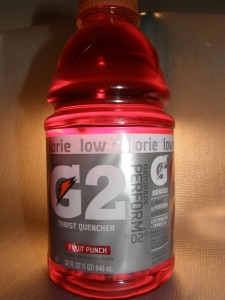
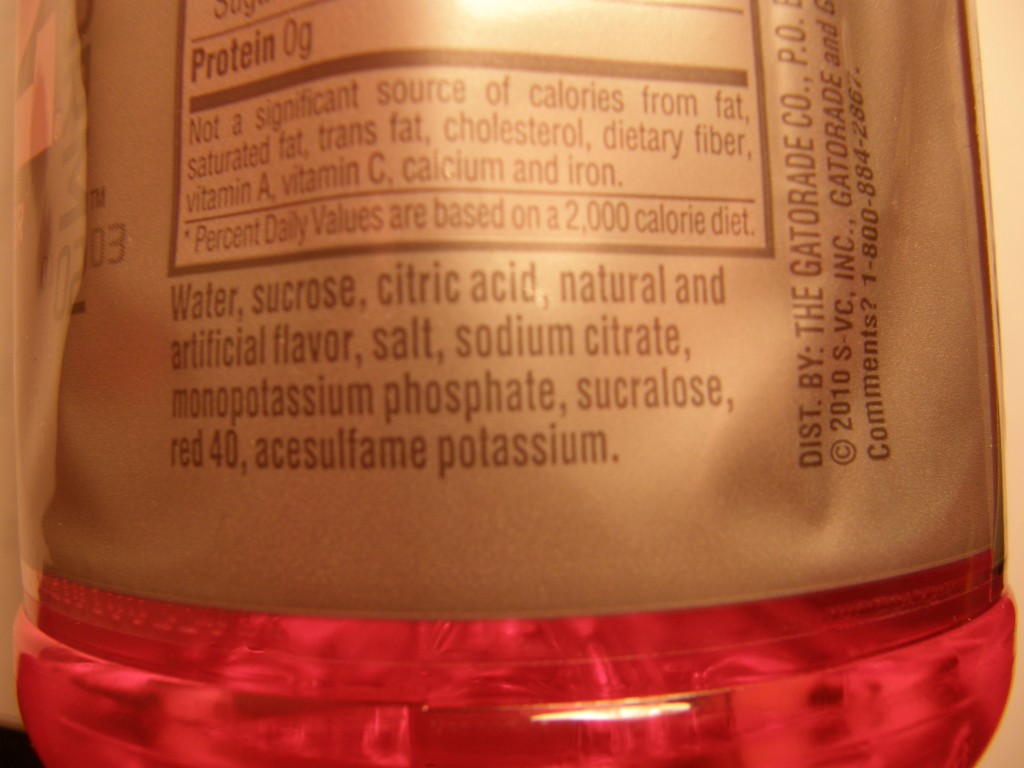
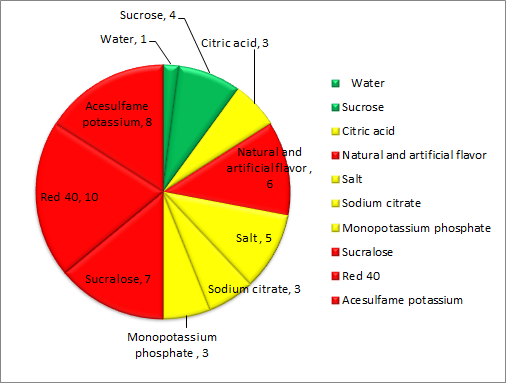

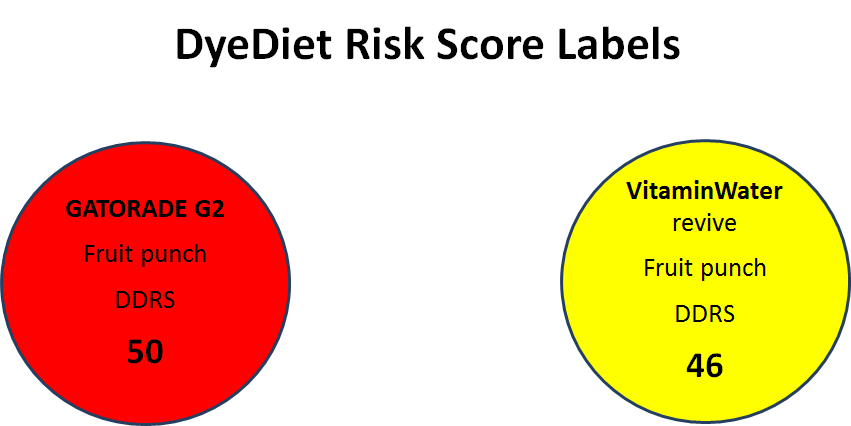
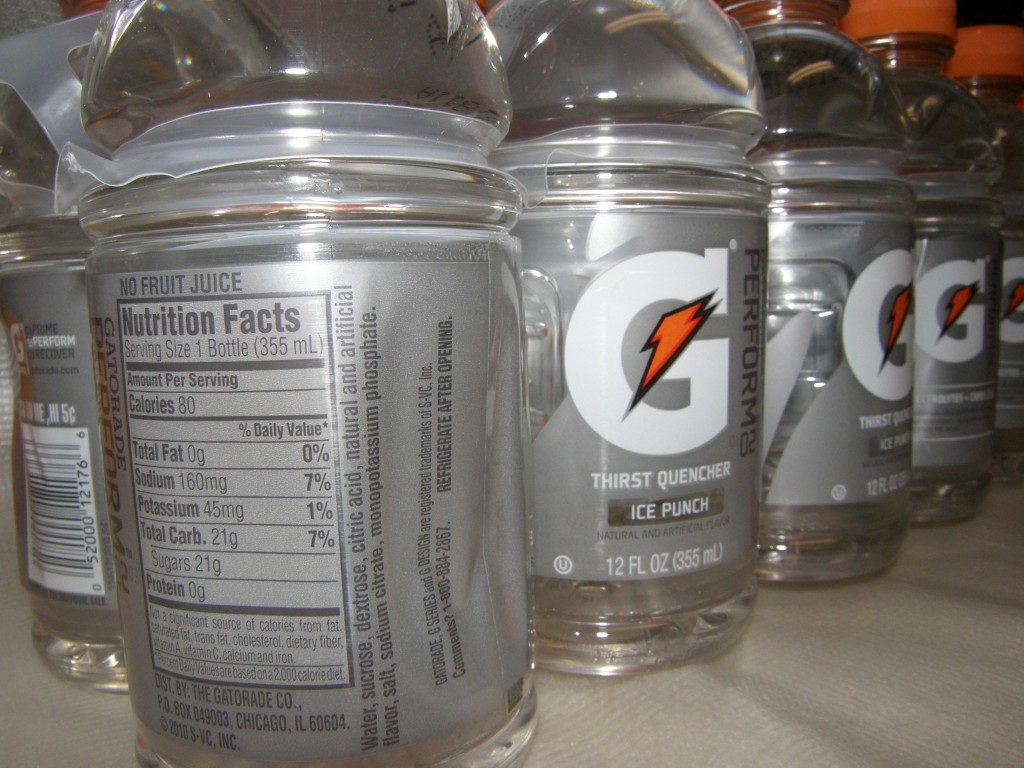
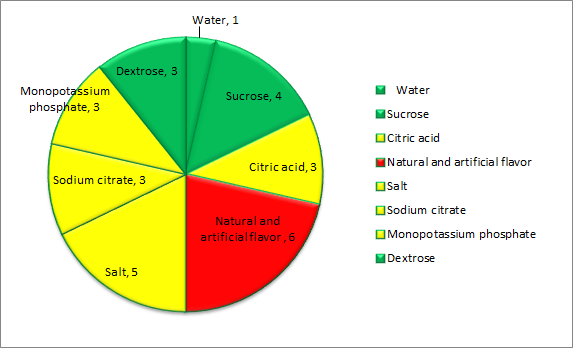
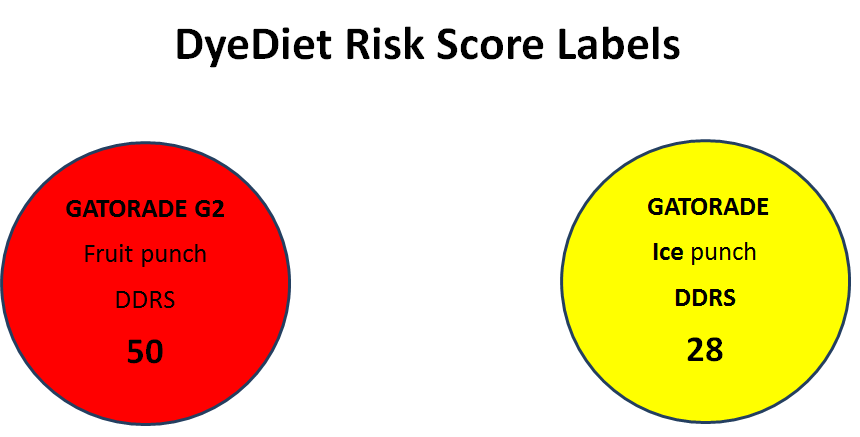




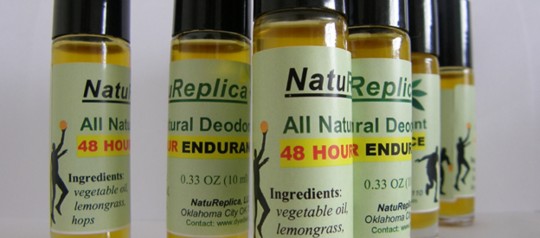
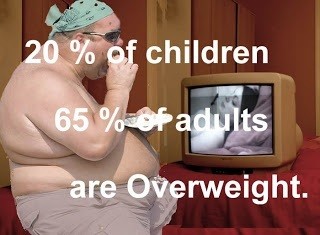
что-то в этом есть, безусловно
Good day! I just would like to give an enormous thumbs up for the good information you could have here on this post. I might be coming again to your weblog for more soon.
To commence earning dollars with your blog, at first use Google adsense but progressively as your traffic
increases, maintain adding more and more cash creating programs for your web site.
thanks !! incredibly useful publish!
Sorry to interrupt, but I thought I could contribute. You said it was unknown how much red 40 was in Gatorade Fruit Punch and I happen to know.
Funny story, just yesterday I did a lab in AP Chem using serial dilutions and a spectrophotometer to determine the amount of red 40 in Gatorade fruit punch and it turns out it is 42.9 mg/L. The accepted value was supposed to be 45.8 mg/L.
Just thought I would share, even though it probably doesn’t matter. Good article.
Cheers
Hello, you should not be sorry – your comment is very valuable. Thank you. Yes, at the time I published the article I did not have an instrument to detect the dye content. But later I have measured and published dye content in a number of Gatorades http://www.dyediet.com/2011/05/01/soft-drinks/how-much-food-dyes-are-in-gatorade/ My later finding for the Gatorade Fruit Punch was higher – 70 mg/L.
But, yes, some 50 mg/L is very common content.
Adults who want to eat a diet based on more natural foods without additives and preservatives also may follow a red dye diet. The Evolution Diet,” for example, bans such foods and author Joseph Morse specifically advises readers not to consume any type of red dye.